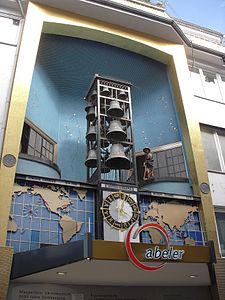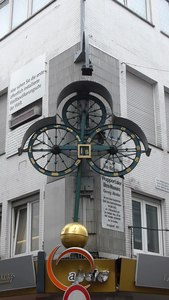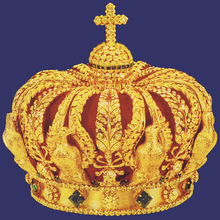Wuppertal clock museum
The Wuppertal Clock Museum , and Clock Museum Abeler was one of the watchmakers - and goldsmith family Abeler in Wuppertal -kept museum with one of the largest and most important private collections of watches . It contained around 2000 exhibits on over 300 m² of exhibition space.
The museum was closed on September 10, 2016, most of the exhibits were bought by the Mannheim auction house Dr. H. Crott auctioned in Frankfurt. In the fall of 2017, the 178-year-old Abeler company began a total sell-out in their two watch shops due to the closure of their business.
history
On March 24, 1955, the Wuppertal master goldsmith and watchmaker Georg Abeler bought the watch collection of the late attorney Heinrich Nils Antoine-Feill on the Hohenzollernring in Cologne . This event is considered to be the hour of birth of the Wuppertal Clock Museum. As the crowning glory of his watch collecting hobby, Georg Abeler opened the Wuppertal watch museum in the vaults of the parent company on Poststrasse in 1958 , which over time has developed into one of the most universal collections on the subject of watches and time measurement with around 2000 exhibits from 5000 years . The museum's director was his son Jürgen Abeler until his death in 2010 , and his son Henrick Abeler since then.
The museum was closed on September 10, 2016. Henrick Abeler explained: "In the past few years the number of visitors has continuously decreased, which meant that in the end we were only open for three hours on Saturdays and offered tours by appointment." According to Abeler, there were no plans for a subsequent use of the rooms of the clock museum in the basement at the time of the closure. The clock and chimes were extensively repaired at the time. In autumn 2017, the company also announced the closure of the watch shop and the discontinuation of operations, which still had a second sales point in the City-Arkaden.
Watch exhibition
The exhibits in the cellar vault of the Abeler jewelery store documented 5000 years of contemporary history and ranged from an Egyptian water clock, Roman and Greek sundials , French pendulum clocks and Napoleonic mantel clocks , stutz clocks in animal shapes, candle and hourglasses , clocks in daggers , buttons and a wooden skull , the extensive development of the wheel clock and decorative musical mechanisms from the Baroque and Rococo to the first continental European atomic clock from 1956 or wristwatches with solar and quartz drives . Most of the clocks on display were restored in our own specialist workshop and were working again. Faithful replicas and reconstructions were made in the special workshop. Approx. 110 exhibits made up the traveling exhibition 5000 Years of Time Measurement .
Hans Thoma wall clock
Carillon
Since 1951, in a niche in the facade of the building in which the museum is located, a carillon has been sounding ( ) with originally 12, then to 28, later to 37 enlarged bells, daily at 10, 12, 16 and 18 Clock with different songs, with two Wuppertal originals from the turn of the century, Zuckerfritz and August Kallenbach (see also: List of Wuppertal originals ), turning their rounds around the bell tower. Every quarter of an hour the Zeitgeist Chronos appears and turns over his hourglass. The reaper death comes on the hour from his door out and so reminiscent of the perishable of all existence. With the swing of his scythe he symbolically cuts off the past hour. The carillon is one of the sights of Wuppertal.
World clock
Since 1958 the time in Honolulu , New York , Moscow , Ceylon and Tokyo as well as Central European Time has been indicated on world time clocks on a Mercator world map under the carillon .
Three-wheel clock
The three-wheel clock on the facade of the building at the corner of Poststrasse and Schwanenstrasse was built in the years before 1962 by Georg Abeler from a horse-drawn vehicle and drawbar that had broken in an accident. The unique specimen received widespread attention in the press, u. a. The Japan Times published an article on the subject on January 27, 1962.
World population clock
To the left of the three-wheel clock is a digital world population clock that is not a clock in the sense of a timepiece, but an electronic human counter. The numbers on this drive indicate the current state of the world population.
- On the facade of the Abeler building:
Three-wheel clock
Further exhibitions
Crowns and insignia
Crowns - symbols of rule of the world was the subject of this exhibition, which includes 85 replicas of crowns and 5 replicas of insignia as well as 34 original objects that document the history and development of the crown symbol . Since 1972, the Crown Collection has been presented to the public in 158 cities in Europe, in New York and in seven cities in Japan. The replicas of the crowns and insignia were made in the company's own goldsmith's shop.
Rings
Jürgen Abeler's enthusiasm for beautiful jewelery, primarily the examples of the finest goldsmithing of the past, is the result of his love for goldsmithing. He was so fascinated by the subject of the history and development of the ring that it resulted in a ring collection consisting of 390 objects with the theme from the signet ring to the love ring - rings from 4 millennia . This collection was sold by Jürgen Abeler's daughters in 2011.
Menus
Since their honeymoon in 1959, Gudrun and Jürgen Abeler have been collecting menus from all over the world. It was only gradually that the idea arose to trace the 500 year old menu and its history. From the abundance of approx. 15,000 menus, the traveling exhibition presents a selection of the 450 most interesting cards with the theme of Lukull on the menus of the world .
Wine labels
In vino veritas - Zeitgeist and art on the world's wine labels was the theme of this unique collection and exhibition, the aim of which is to provide a large overview of the history and design of wine labels in all growing areas of the world with around 20,000 exhibits.
Visitors
The clock museum was visited by over a million visitors. There were politicians like Konrad Adenauer , many actors and international delegations.
See also
literature
- Jürgen Abeler : The Wuppertal Clock Museum . Walter de Gruyter, Berlin a. a. 1971, ISBN 3-11-002469-1 . ( Museums of cultural history in Germany 12).
- Jürgen Abeler: Crowns. Sign of rulership of the world . Photography: Vok Dams. Econ, Düsseldorf a. a. 1972, ISBN 3-430-11002-5 .
- Jürgen Abeler: Ullstein watch book. A cultural history of time measurement . Ullstein, Frankfurt am Main a. a. 1975, ISBN 3-550-17462-4 .
- Jürgen Abeler: 5000 years of time measurement. Shown on the clocks of the Wuppertal clock museum and the J. u. G. Abeler traveling exhibition . 2nd expanded edition. Wuppertal Clock Museum, Wuppertal 1978.
- Jürgen Abeler: The Wuppertal Clock Museum . Schnell & Steiner, Munich a. a. 1983, ( Schnell Art Guide No. 1411).
- Jürgen Abeler: Master of watchmaking. 2nd greatly expanded edition. Self-published 2010 (over 20,000 names and dates of watchmakers from German-speaking countries).
Web links
- Official website of the watch museum. April 16, 2016, archived from the original ; accessed on October 6, 2019 .
- virtual tour through the Wuppertal clock museum.
Individual evidence
- ↑ a b Clock Museum will be closed. In: Westdeutsche Zeitung of July 7, 2016
- ↑ Special collector's items from the Wuppertal Watch Museum in the 94th auction (PDF)
- ↑ Auction: Watches from Wuppertal. ( Memento from October 14, 2017 in the Internet Archive ) In: Westdeutscher Rundfunk , accessed on November 14, 2016.
- ↑ Homepage of the company, accessed on November 1, 2017.
- ↑ Proof of historical sources in companies. In: German Economic Archive, accessed July 28, 2010
- ↑ Source number 262. ( Memento from June 12, 2007 in the Internet Archive ) University of Bonn - Department of Language and Communication; Retrieved November 12, 2013
- ↑ A house full of hours. In: Kölner Stadtanzeiger , November 17, 2005; accessed November 22, 2017
- ^ Local time - Georg Abeler. West German Broadcasting ; Retrieved May 12, 2008
Coordinates: 51 ° 15 ′ 27.7 " N , 7 ° 8 ′ 51.8" E









